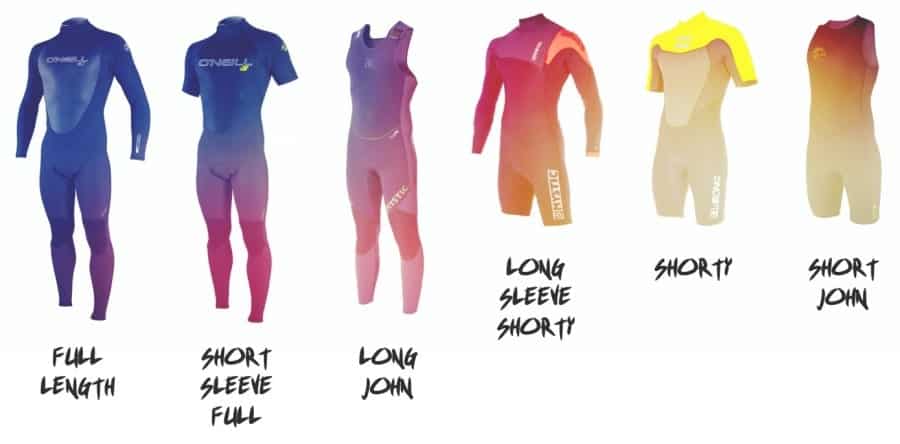A good wetsuit can be an essential part of your surfing gear. Even in tropical places like Hawaii, the water can get chilly during the winter months. Having a properly fitted wetsuit will keep you out on the water longer than without.
But choosing the right wetsuit can take a little time. Nothing is worse than an ill fitting suit while you’re trying to catch some waves.
So just how tight should your wetsuit be? A wetsuit should fit snug, but not be restrictive. Wetsuits are made to be tight. They’re essentially a second skin which is part of what makes them work.
Wetsuits keep you warm by allowing water into the fabric and trapping it there against your skin. Your own body temperature heats this water, acting like an insulator.
If your wetsuit is too loose, meaning there are folds or gaps in your suit, the wetsuit won’t be able to do its job. The gaps and folds will allow water through them, defeating the purpose of wearing the wetsuit.
A too loose wetsuit also creates drag. The last thing you need while paddling for a wave is to be held back by your gear.
However, you also don’t want your wetsuit too tight. First, it will restrict your movement.
Again, a wetsuit is like a second skin. If you’re fighting against the suit while paddling, etc, you’re using too much energy. A wetsuit should prolong your ability to stay in the water versus shorten it.
A too tight wetsuit will also degrade your suit much faster. While neoprene, the fabric wetsuits are made from, is meant to be stretchy, over stretching it will make it thinner.
Since half of finding a suit is purchasing the right thickness, this is a major issue.
Most importantly though, a too tight wetsuit can put too much pressure on the chest, causing trouble breathing, and restricting your endurance. You should be able to take strong deep breaths in your wetsuit.
How To Choose The Right Fitting Wetsuit
We discussed why a suit shouldn’t be too tight or too loose, but how exactly should it fit and feel?
The right suit should hug your body without inhibiting any movements. When trying on wetsuits, make sure to move around and test out the actions you’ll be doing out in the waves.
If it’s your first wetsuit, it will definitely feel weird and be a new sensation, but it shouldn’t be uncomfortable to wear.
Check the different areas of the fit to make sure it’s right. Every brand and manufacturer uses different models and measurements to create their products, so every brand will fit differently.
You may have to try on lots of suits to find one that fits properly. Key points to watch out for are the arms/armpits, lower back, hips and thighs. In the arms, practice your paddling motion to test the fit.
You should notice a difference from your bare arms, but movement shouldnt be hindered. Take some deep breaths to make sure your suit isn’t too tight across the chest.
The lower back should be flat against your skin. If it buckles or conversely stretches up off your back, the suit doesn’t fit properly.
When checking the lower body fit, lift your knees up. Watch out for pulling or a lot of resistance, another sign your fit isn’t right.
Make sure the fabric across the hips is snug, fitted against the groin versus loose. Your wetsuit should be smooth against the body without pulling or stretching.

Putting On Your Wetsuit
Once you’ve found the right wetsuit, it can be tricky to put it on. Even though you don’t want it too tight, it will still be snug and that can bring challenges when you’re putting it on.
Start from the bottom up. From sitting, work on getting your feet through the leg opening. Once you have both feet through, stand up and pull the suit up over your hips.
With your suit half way on, adjust through the legs and hips for your suit to fit comfortably. Then tackle the upper body.
Try bunching up the sleeves so you can get your hand through the armhole and pull the rest of the arm up from there and repeat on the opposite side. Depending on your suit, you may need help zipping up the back.
If you’re struggling to get your suit over your limbs, there’s a couple tricks you can try.
Place a plastic bag over your hands or feet. The bag will create less friction than your skin while sliding your wetsuit over your body.
Or, you can turn your suit inside out. Once your suit is inside out, use the same steps starting from the bottom up.
Instead of placing your feet all the way through the leg opening, put your feet directly in the foot holes and roll the suit up over your legs.
Repeat with the arms. Place your hands directly in the wrist opening and roll your wetsuit up over the arms.
You can also try putting your suit on in the water. The water will make your suit stretch more, making it easier to pull it on.
How Do You Take Care Of A Wetsuit?
Wetsuits require proper care. Without proper washing and drying, the fabric of your suit will degrade and lose its ability to keep you warm much faster.
Proper care will keep your suit like new for a long time. And considering the financial investment in a good wetsuit, you want to keep it fresh as long as possible.
Fresh Water Rinse
First, make sure to give your wetsuit a thorough fresh water rinse after every surf. Salt water is the biggest culprit in fabric degradation, next to direct sunlight.
You can quickly rinse off at the beach, but take the time to hose down your suit once you get home.
Soap
Although you don’t need to soap up your wetsuit after every surf, you should clean it after a few uses.
Use a specific wetsuit shampoo, or a mild detergent like baby shampoo.
Fill your tub with cold or lukewarm water, but never hot water. Hot water will ruin neoprene. Place your wetsuit in the filled tub and add your soap.
No need to scrub hard, but do make sure your wetsuit gets fully sudsed up. Rinse thoroughly and air dry.
Do not put your wetsuit in the washing machine or dryer. The fabric of your wetsuit is too delicate to be thrown around the washing machine. And as previously mentioned, heat will ruin your suit.
Air Dry
Be sure to dry both sides of your wetsuit, inside out first. Since your suit is designed to hold water, the exposed side of your suit will dry first.
So turn it inside out to allow this side to dry, then flip it a day or so later to dry the other side. If you skip this step, bacteria can grow inside your suit, making it stinky and ruining your fabric.
Don’t hang your suit through the shoulders. This weight of your wet suit will pull on the shoulders, causing irreversible stretching.
Instead, fold it over a hanger and hang it up on your shower pole, in your garage or other shady spot.
Don’t lay it out in the sun to dry. Sun will break down the rubber your suit is made of very quickly. So this is a number 1 no no.
Styles of Wetsuit

The last thing to take into account when choosing a wetsuit is what style you need. This will be based on the temperature of the water you’re surfing in, but is also based on preference.
Surfers mostly wear a spring suit or full suit, but there’s a wide array to choose from based on your needs.
Vest
A vest will cover just your chest. Designed for warm water use, this will mostly keep the windchill off you.
Jacket
Jackets can be both short sleeve or long sleeve, and only cover the upper body. They are also made for warmer waters but will provide more warmth and protection than a vest.
Short John
A short john is like a vest with shorts. It adds a layer of protection to the hips and thighs, but leaves the arms exposed.
Long John
The same as a short john but with full length legs. This style suit offers warmth to the body while leaving the arms free from any restriction.
Springsuit
Perfect for medium to cool water, this suit is aptly named for “spring” conditions. It is similar to a short john but it has short sleeves instead of no sleeves.
This suit will provide warmth while keeping your motions unrestricted
Short Arm Steamer
Like a spring suit but with full legs. This is one step below a full suit and is meant for colder water.
Fullsuit
A full suit has long sleeves and fully covers the legs. This provides the most warmth and is best for winter surfing and otherwise cold waters.
When choosing your suit makes sure it has the proper thickness. This will be indicated by two numbers like 3/2 or 4/3.
Thickness is measured in millimeters. The first number is the thickness of the core, the second is the thickness of the limbs. The thicker the suit, the more warmth.
Check the average temperatures at your local surf spot to help choose.
Related Questions
What Do You Wear Under a Wetsuit?
As important as finding a good suit is what you wear underneath it. Most people opt to wear nothing under their wetsuits, which is totally fine.
But you can also just wear your regular board shorts or bikini. There are even special clothes you can get that will provide extra warmth, but most surfers don’t need them.
Will a Wetsuit Loosen Up Over Time?
You want your wetsuit tight enough, but will it loosen up? This answer is twofold.
First, once in the water, a wetsuit will loosen up versus when it’s dry, but not a huge amount. This is part of why it’s important to make sure you find the right fit.
Second, wear and tear over time will stretch out a wetsuit. This will make the fabric thinner and less useful in keeping you warm. Once the fabric has degraded on your wetsuit, it’s time to buy a new one.


